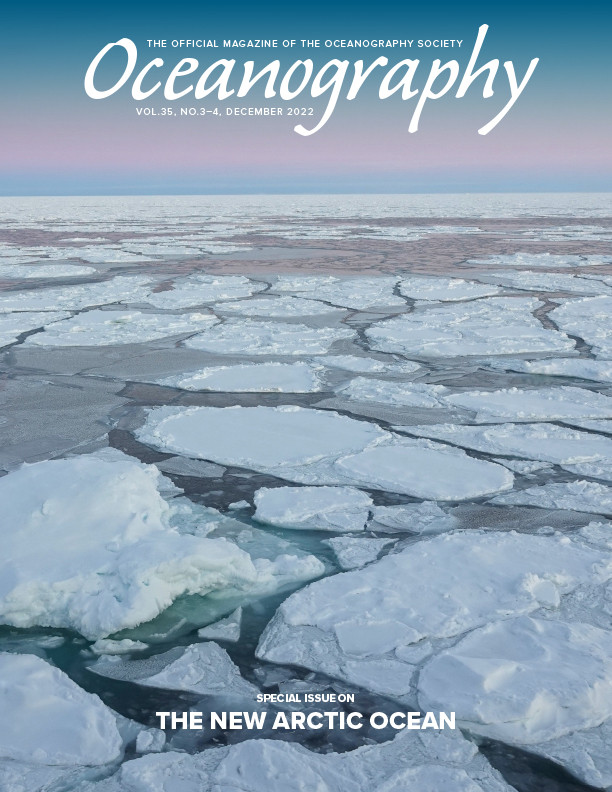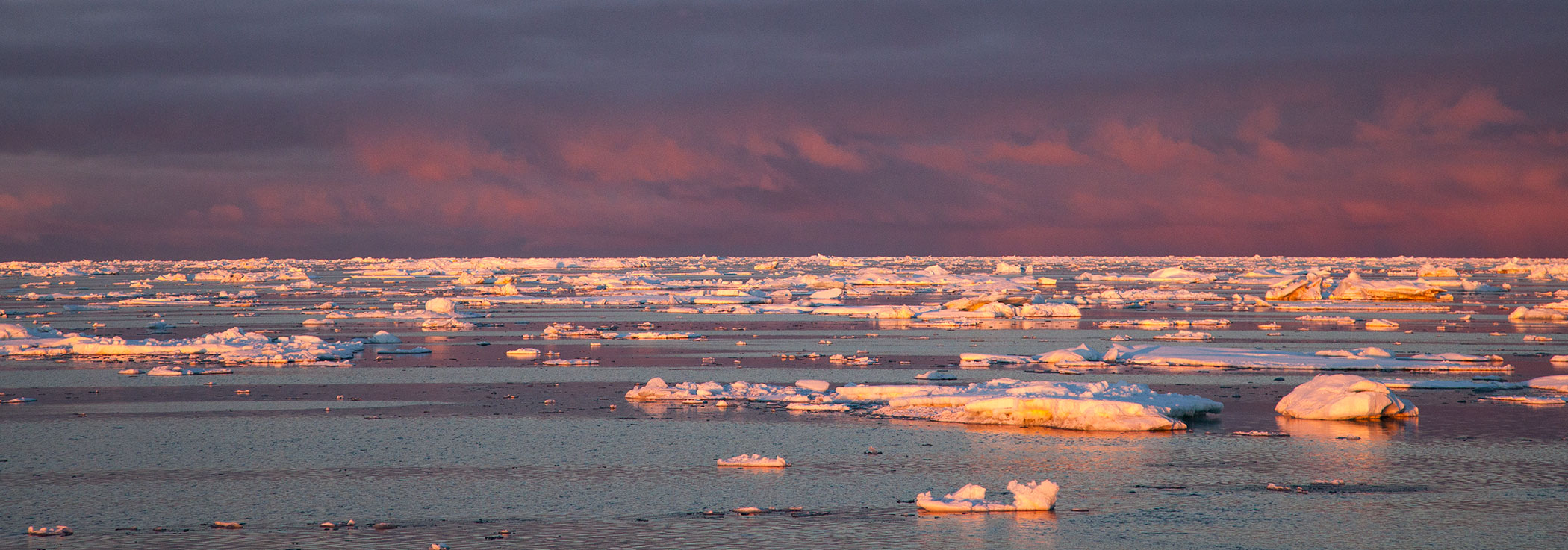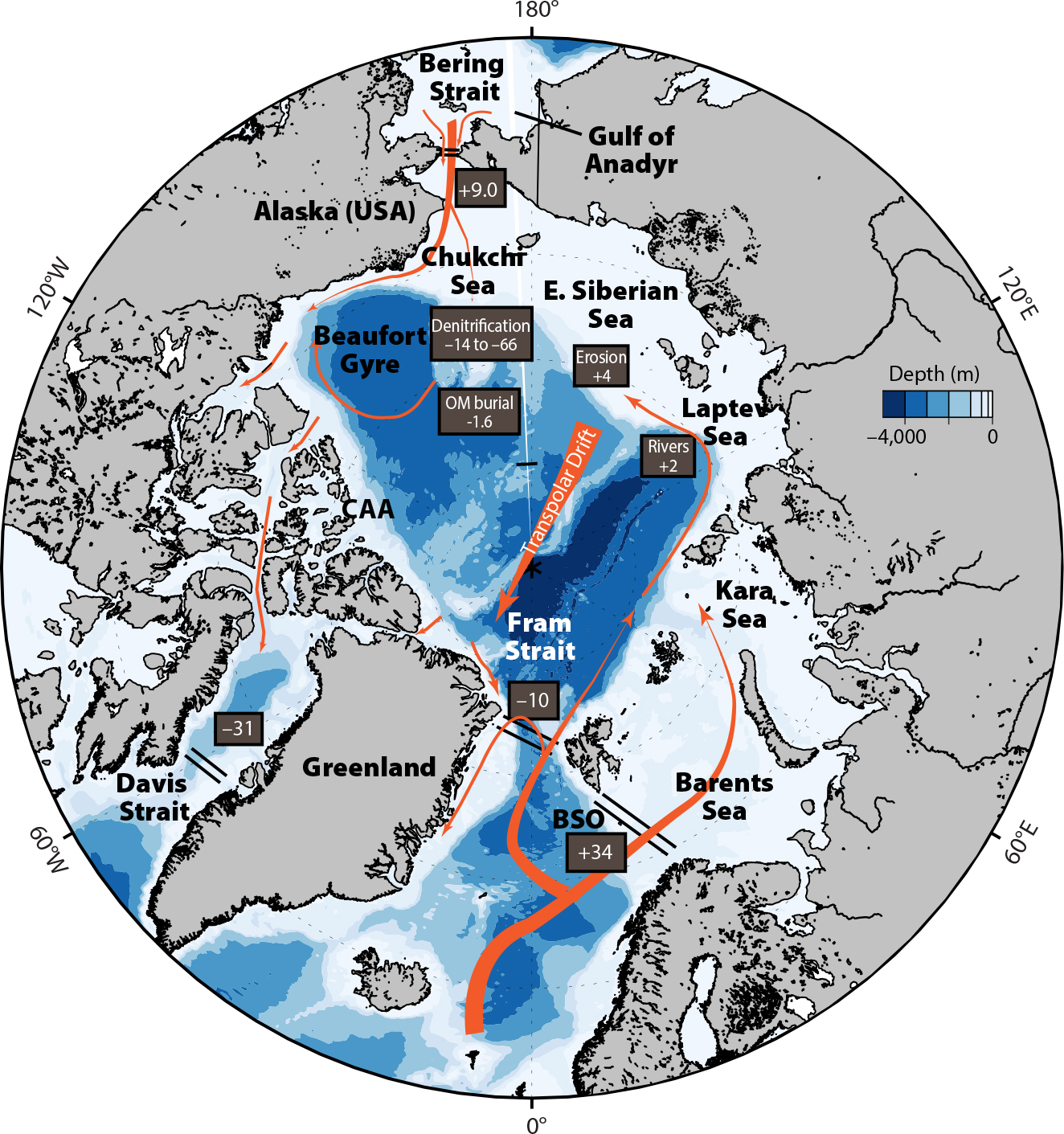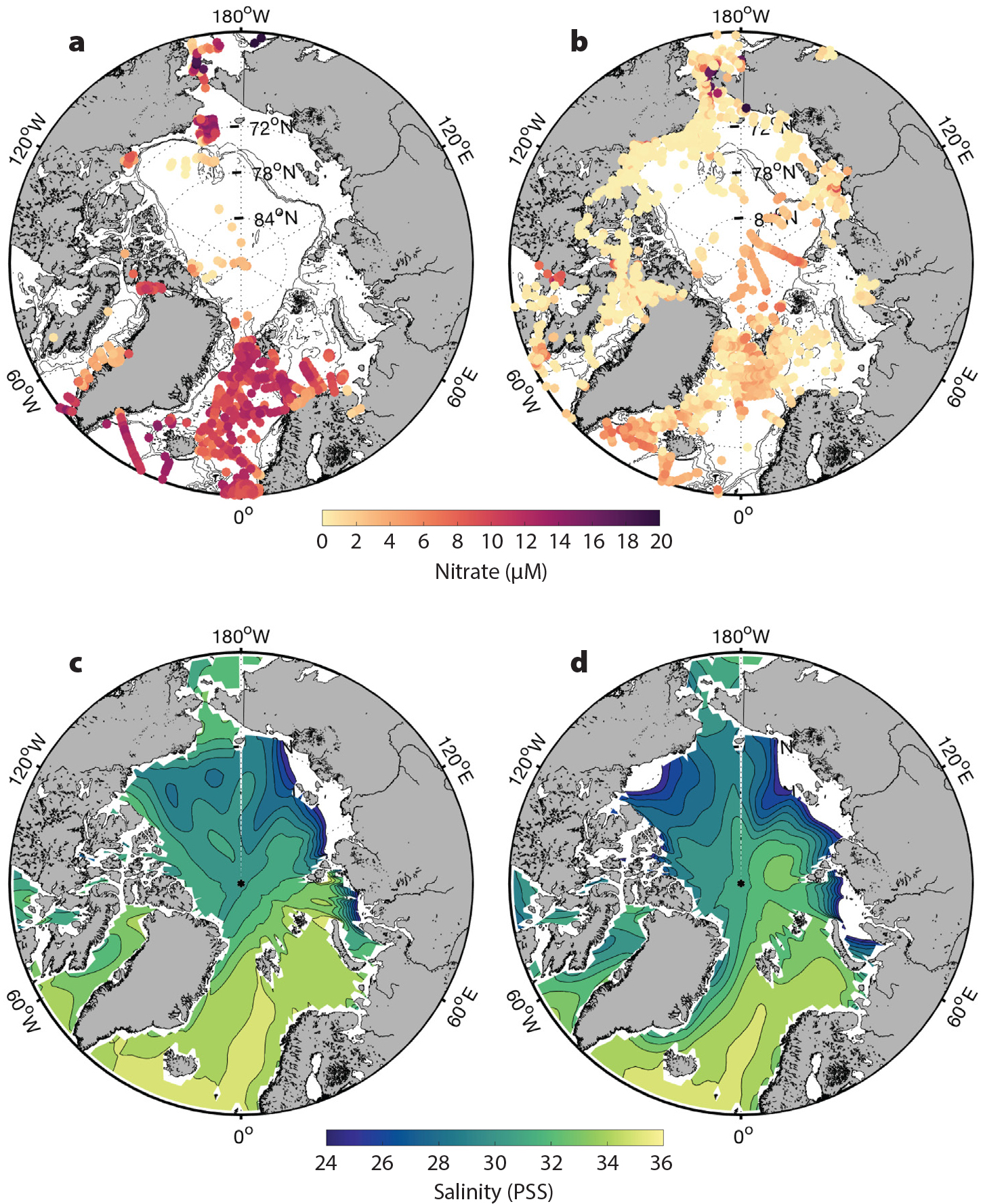Anderson, L.G., S. Jutterström, S. Hjalmarsson, L. Wåhlström, and I.P. Semiletov. 2009. Out-gassing of CO2 from Siberian Shelf seas by terrestrial organic matter decomposition. Geophysical Research Letters 36(20), https://doi.org/10.1029/2009GL040046.
Ardyna, M., M. Babin, M. Gosselin, E. Devred, L. Rainville, and J.-É. Tremblay. 2014. Recent Arctic Ocean sea ice loss triggers novel fall phytoplankton blooms. Geophysical Research Letters 41(17):6,207–6,212, https://doi.org/10.1002/2014GL061047.
Ardyna, M., and K.R. Arrigo. 2020. Phytoplankton dynamics in a changing Arctic Ocean. Nature Climate Change 10(10):892–903, https://doi.org/10.1038/s41558-020-0905-y.
Arrigo, K.R., and G.L. van Dijken. 2015. Continued increases in Arctic Ocean primary production. Progress in Oceanography 136:60–70, https://doi.org/10.1016/j.pocean.2015.05.002.
Årthun, M., T. Eldevik, L.H. Smedsrud, Ø. Skagseth, and R.B. Ingvaldsen. 2012. Quantifying the Influence of Atlantic heat on Barents Sea ice variability and retreat. Journal of Climate 25(13):4,736–4,743, https://doi.org/10.1175/JCLI-D-11-00466.1.
Balch, W.M. 2018. The ecology, biogeochemistry, and optical properties of coccolithophores. Annual Review of Marine Science 10(1):71–98, https://doi.org/10.1146/annurev-marine-121916-063319.
Bates, N.R., and J.T. Mathis. 2009. The Arctic Ocean marine carbon cycle: Evaluation of air-sea CO2 exchanges, ocean acidification impacts and potential feedbacks. Biogeosciences 6(11):2,433–2,459.
Beaird, N.L., E.L. Shroyer, L.W. Juranek, B. Hales, and M.A. Goñi. 2020. Nutrient-rich gravity current formed by upwelling in Barrow Canyon: High-resolution observations. Journal of Geophysical Research: Oceans 125(7), https://doi.org/10.1029/2020JC016160.
Boyer, T.P., O,K. Baranova, M. Biddle, D.R. Johnson, A.V. Mishonov, C.R. Paver, D. Seidov, and M.M. Zweng. 2014. Arctic Ocean Regional Climatology (NCEI Accession 0115771). NOAA National Centers for Environmental Information data set, accessed February 2022, https://doi.org/10.7289/v5qc01j0.
Cai, W.-J., L. Chen, B. Chen, Z. Gao, S.H. Lee, J. Chen, D. Pierrot, K. Sullivan, Y. Wang, X. Hu, and others. 2010. Decrease in the CO2 uptake capacity in an ice-free Arctic Ocean basin. Science 329(5991):556–559, https://doi.org/10.1126/science.1189338.
Carmack, E., and D.C. Chapman. 2003. Wind-driven shelf/basin exchange on an Arctic shelf: The joint roles of ice cover extent and shelf-break bathymetry. Geophysical Research Letters 30(14), https://doi.org/10.1029/2003GL017526.
Carmack, E., D. Barber, J. Christensen, R. Macdonald, B. Rudels, and E. Sakshaug. 2006. Climate variability and physical forcing of the food webs and the carbon budget on panarctic shelves. Progress in Oceanography 71(2–4):145–181, https://doi.org/10.1016/j.pocean.2006.10.005.
Carmack, E.C., M. Yamamoto-Kawai, T.W.N. Haine, S. Bacon, B.A. Bluhm, C. Lique, H. Melling, I.V. Polyakov, F. Straneo, M.-L. Timmermans, and W.J. Williams. 2016. Freshwater and its role in the Arctic marine system: Sources, disposition, storage, export, and physical and biogeochemical consequences in the Arctic and global oceans. Journal of Geophysical Research: Biogeosciences 121(3):675–717, https://doi.org/10.1002/2015JG003140.
Castro de la Guardia, L., Y. Garcia-Quintana, M. Claret, X. Hu, E.D. Galbraith, and P.G. Myers. 2019. Assessing the role of high-frequency winds and sea ice loss on Arctic phytoplankton blooms in an ice-ocean-biogeochemical model. Journal of Geophysical Research: Biogeosciences 124(9):2,728–2,750, https://doi.org/10.1029/2018JG004869.
Chang, B.X., and A.H. Devol. 2009. Seasonal and spatial patterns of sedimentary denitrification rates in the Chukchi sea. Deep Sea Research Part II 56(17):1,339–1,350, https://doi.org/10.1016/j.dsr2.2008.10.024.
Codispoti, L.A., V. Kelly, A. Thessen, P. Matrai, S. Suttles, V. Hill, M. Steele, and B. Light. 2013. Synthesis of primary production in the Arctic Ocean: Part III. Nitrate and phosphate based estimates of net community production. Progress in Oceanography 110:126–150, https://doi.org/10.1016/j.pocean.2012.11.006.
Crawford, A.D., and M.C. Serreze. 2017. Projected changes in the Arctic frontal zone and summer Arctic cyclone activity in the CESM large ensemble. Journal of Climate 30(24):9,847–9,869, https://doi.org/10.1175/JCLI-D-17-0296.1.
Drake, T.W., S.E. Tank, A.V. Zhulidov, R.M. Holmes, T. Gurtovaya, and R.G.M. Spencer. 2018. Increasing alkalinity export from large Russian Arctic rivers. Environmental Science & Technology 52(15):8,302–8,308, https://doi.org/10.1021/acs.est.8b01051.
Dugdale, R.C., and J.J. Goering. 1967. Uptake of new and regenerated forms of nitrogen in primary productivity. Limnology and Oceanography 12(2):196–206, https://doi.org/10.4319/lo.1967.12.2.0196.
Else, B.G.T., R.J. Galley, B. Lansard, D.G. Barber, K. Brown, L.A. Miller, A. Mucci, T.N. Papakyriakou, J.-É. Tremblay, and S. Sysgaard. 2013. Further observations of a decreasing atmospheric CO2 uptake capacity in the Canada Basin (Arctic Ocean) due to sea ice loss. Geophysical Research Letters 40(6):1,132–1,137, https://doi.org/10.1002/grl.50268.
Evans, W., J.T. Mathis, J.N. Cross, N.R. Bates, K.E. Frey, B.G.T. Else, T.N. Papkyriakou, M.D. DeGrandpre, F. Islam, W.-J. Cai, and others. 2015. Sea-air CO2 exchange in the western Arctic coastal ocean. Global Biogeochemical Cycles 29(8):1,190–1,209, https://doi.org/10.1002/2015GB005153.
Frey, K.E., and J.W. McClelland. 2009. Impacts of permafrost degradation on Arctic river biogeochemistry. Hydrological Processes 23(1):169–182, https://doi.org/10.1002/hyp.7196.
Frey, K.E., J. Clement Kinney, L.V. Stock, and R. Osinski. 2022. Observations of declining primary productivity in the western Bering Strait. Oceanography 35(3–4):140–143, https://doi.org/10.5670/oceanog.2022.123.
Granger, J., D.M. Sigman, J. Gagnon, J. Tremblay, and A. Mucci. 2018. On the properties of the Arctic halocline and deep water masses of the Canada Basin from nitrate isotope ratios. Journal of Geophysical Research: Oceans 123(8):5,443–5,458, https://doi.org/10.1029/2018JC014110.
Haine, T.W.N., B. Curry, R. Gerdes, E. Hansen, M. Karcher, C. Lee, B. Rudels, G. Spreen, L. de Steur, K.D. Stewart, and R. Woodgate. 2015. Arctic freshwater export: Status, mechanisms, and prospects. Global and Planetary Change 125:13–35, https://doi.org/10.1016/j.gloplacha.2014.11.013.
Hauri, C., P. Winsor, L.W. Juranek, A.M.P. McDonnell, T. Takahashi, and J.T. Mathis. 2013. Wind-driven mixing causes a reduction in the strength of the continental shelf carbon pump in the Chukchi Sea: CO2 outgassing in the Chukchi Sea. Geophysical Research Letters 40(22):5,932–5,936, https://doi.org/10.1002/2013GL058267.
Henley, S.F., M. Porter, L. Hobbs, J. Braun, R. Guillaume-Castel, E.J. Venables, E. Dumont, and F. Cottier. 2020. Nitrate supply and uptake in the Atlantic Arctic sea ice zone: Seasonal cycle, mechanisms and drivers. Philosophical Transactions of the Royal Society A 378(2181):20190361, https://doi.org/10.1098/rsta.2019.0361.
Hill, V., and G. Cota. 2005. Spatial patterns of primary production on the shelf, slope and basin of the Western Arctic in 2002. Deep Sea Research Part II 52(24–26):3,344–3,354, https://doi.org/10.1016/j.dsr2.2005.10.001.
Holmes, R.M., J.W. McClelland, B.J. Peterson, S.E. Tank, E. Bulygina, T.I. Eglinton, V.V. Gordeev, T.Y. Gurtovaya, P.A. Raymond, D.J. Repeta, and others. 2012. Seasonal and annual fluxes of nutrients and organic matter from large rivers to the Arctic Ocean and surrounding seas. Estuaries and Coasts 35(2):369–382, https://doi.org/10.1007/s12237-011-9386-6.
Jacobs, P., N.J.L. Lenssen, G.A. Schmidt, and R.A. Rohde. 2021. The Arctic is now warming four times as fast as the rest of the globe. Abstract A13E-02, paper presented at the American Geophysical Union Fall Meeting, December 13–17, 2021.
Kahru, M., V. Brotas, M. Manzano-Sarabia, and B.G. Mitchell. 2011. Are phytoplankton blooms occurring earlier in the Arctic? Global Change Biology 17(4):1,733–1,739, https://doi.org/10.1111/j.1365-2486.2010.02312.x.
Kipp, L.E., M.A. Charette, W.S. Moore, P.B. Henderson, and I.G. Rigor. 2018. Increased fluxes of shelf-derived materials to the central Arctic Ocean. Science Advances 4(1):eaao1302, https://doi.org/10.1126/sciadv.aao1302.
Kirchman, D.L., X.A.G. Morán, and H. Ducklow. 2009. Microbial growth in the polar oceans—Role of temperature and potential impact of climate change. Nature Reviews Microbiology 7(6):451–459, https://doi.org/10.1038/nrmicro2115.
Ladd, C., L.B. Eisner, S.A. Salo, C.W. Mordy, and M.D. Iglesias-Rodriguez. 2018. Spatial and temporal variability of coccolithophore blooms in the eastern Bering Sea. Journal of Geophysical Research: Oceans 123(12):9,119–9,136, https://doi.org/10.1029/2018JC014302.
Lavrentyev, P.J., G. Franzè, and F.B. Moore. 2019. Microzooplankton distribution and dynamics in the eastern Fram Strait and the Arctic Ocean in May and August 2014. Frontiers in Marine Science 6:264, https://doi.org/10.3389/fmars.2019.00264.
Le Fouest, V., M. Babin, and J.-É. Tremblay. 2013. The fate of riverine nutrients on Arctic shelves. Biogeosciences 10(6):3,661–3,677, https://doi.org/10.5194/bg-10-3661-2013.
Lewis, K.M., G.L. van Dijken, and K.R. Arrigo. 2020. Changes in phytoplankton concentration now drive increased Arctic Ocean primary production. Science 369(6500):198–202, https://doi.org/10.1126/science.aay8380.
Li, W.K.W., F.A. McLaughlin, C. Lovejoy, and E.C. Carmack. 2009. Smallest algae thrive as the Arctic Ocean freshens. Science 326(5952):539–539, https://doi.org/10.1126/science.1179798.
Mathis, J.T., R.S. Pickart, R.H. Byrne, C.L. McNeil, G.W.K. Moore, L.W. Juranek, X. Liu, J. Ma, R.A. Easley, M.M. Elliot, and others. 2012. Storm-induced upwelling of high pCO2 waters onto the continental shelf of the western Arctic Ocean and implications for carbonate mineral saturation states. Geophysical Research Letters 39(7), https://doi.org/10.1029/2012GL051574.
Matrai, P.A., E. Olson, S. Suttles, V. Hill, L.A. Codispoti, B. Light, and M. Steele. 2013. Synthesis of primary production in the Arctic Ocean: Part I. Surface waters, 1954–2007. Progress in Oceanography 110:93–106, https://doi.org/10.1016/j.pocean.2012.11.004.
McClelland, J.W., R.M. Holmes, K.H. Dunton, and R.W. Macdonald. 2012. The Arctic Ocean estuary. Estuaries and Coasts 35(2):353–368, https://doi.org/10.1007/s12237-010-9357-3.
McLaughlin, F.A., and E.C. Carmack. 2010. Deepening of the nutricline and chlorophyll maximum in the Canada Basin interior, 2003–2009. Geophysical Research Letters 37(24), https://doi.org/10.1029/2010GL045459.
Mordy, C.W., S. Bell, E.D. Cokelet, C. Ladd, G. Lebon, P. Proctor, P. Stabeno, D. Strausz, E. Wisegarver, and K. Wood. 2020. Seasonal and interannual variability of nitrate in the eastern Chukchi Sea: Transport and winter replenishment. Deep Sea Research Part II 177:104807, https://doi.org/10.1016/j.dsr2.2020.104807.
Napp, J.M., and G.L. Hunt. 2001. Anomalous conditions in the south-eastern Bering Sea 1997: Linkages among climate, weather, ocean, and biology. Fisheries Oceanography 10(1):61–68, https://doi.org/10.1046/j.1365-2419.2001.00155.x.
Neukermans, G., L. Oziel, and M. Babin. 2018. Increased intrusion of warming Atlantic water leads to rapid expansion of temperate phytoplankton in the Arctic. Global Change Biology 24(6):2,545–2,553, https://doi.org/10.1111/gcb.14075.
Nishino, S., Y. Kawaguchi, J. Inoue, T. Hirawake, A. Fujiwara, R. Futsuki, J. Onodera, and M. Aoyama. 2015. Nutrient supply and biological response to wind-induced mixing, inertial motion, internal waves, and currents in the northern Chukchi Sea. Journal of Geophysical Research: Oceans 120(3):1,975–1,992, https://doi.org/10.1002/2014JC010407.
Okkonen, S.R., C.J. Ashjian, R.G. Campbell, J.T. Clarke, S.E. Moore, and K.D. Taylor. 2011. Satellite observations of circulation features associated with a bowhead whale feeding ‘hotspot’ near Barrow, Alaska. Remote Sensing of Environment 115(8):2,168–2,174, https://doi.org/10.1016/j.rse.2011.04.024.
Olsen, A., L.G. Anderson, and C. Heinze. 2015. Arctic carbon cycle: Patterns, impacts and possible changes. Pp. 95–115 in The New Arctic. B. Evengård, J. Nymand Larsen, and Ø. Paasche, eds, Springer International Publishing, https://doi.org/10.1007/978-3-319-17602-4_8.
Ouyang, Z., D. Qi, L. Chen, T. Takahashi, W. Zhong, M.D. DeGrandpre, B. Chen, Z. Gao, S. Nishino, A. Murata, and others. 2020. Sea-ice loss amplifies summertime decadal CO2 increase in the western Arctic Ocean. Nature Climate Change 10(7):678–684, https://doi.org/10.1038/s41558-020-0784-2.
Oziel, L., G. Neukermans, M. Ardyna, C. Lancelot, J.-L. Tison, P. Wassmann, J. Sirven, D. Ruiz-Pino, and J.-C. Gascard. 2017. Role for Atlantic inflows and sea ice loss on shifting phytoplankton blooms in the Barents Sea. Journal of Geophysical Research: Oceans 122(6):5,121–5,139, https://doi.org/10.1002/2016JC012582.
Pabi, S., G.L. van Dijken, and K.R. Arrigo. 2008. Primary production in the Arctic Ocean, 1998–2006. Journal of Geophysical Research: Oceans 113(C8), https://doi.org/10.1029/2007JC004578.
Pacini, A., G.W.K. Moore, R.S. Pickart, C. Nobre, F. Bahr, K. Våge, and K.R. Arrigo. 2019. Characteristics and transformation of Pacific Winter Water on the Chukchi Sea shelf in late spring. Journal of Geophysical Research: Oceans 124(10):7,153–7,177, https://doi.org/10.1029/2019JC015261.
Peterson, B.J., R.M. Holmes, J.W. McClelland, C.J. Vörösmarty, R.B. Lammers, A.I. Shiklomanov, I.A. Shiklomanov, and S. Rahmstorf. 2002. Increasing river discharge to the Arctic Ocean. Science 298(5601):2,171–2,173, https://doi.org/10.1126/science.1077445.
Pickart, R.S., L.M. Schulze, G.W.K. Moore, M.S. Charette, K.R. Arrigo, G. van Dijken, and S.L. Danielson. 2013. Long-term trends of upwelling and impacts on primary productivity in the Alaskan Beaufort Sea. Deep Sea Research Part I 79:106–121, https://doi.org/10.1016/j.dsr.2013.05.003.
Pipko, I.I., S.P. Pugach, I.P. Semiletov, L.G. Anderson, N.E. Shakhova, Ö. Gustafsson, I.A. Repina, E.A. Spivak, A.N. Charkin, A.N. Salyuk, and others. 2017. The spatial and interannual dynamics of the surface water carbonate system and air-sea CO2 fluxes in the outer shelf and slope of the Eurasian Arctic Ocean. Ocean Science 13(6):997–1,016, https://doi.org/10.5194/os-13-997-2017.
Polyakov, I.V., M.B. Alkire, B.A. Bluhm, K.A. Brown, E.C. Carmack, M. Chierici, S.L. Danielson, I. Ellingsen, E.A. Ershova, K. Gårdfeldt, and others. 2020. Borealization of the Arctic Ocean in response to anomalous advection from sub-Arctic seas. Frontiers in Marine Science 7:491, https://doi.org/10.3389/fmars.2020.00491.
Randelhoff, A., and A. Sundfjord. 2018. Short commentary on marine productivity at Arctic shelf breaks: Upwelling, advection and vertical mixing. Ocean Science 14(2):293–300, https://doi.org/10.5194/os-14-293-2018.
Randelhoff, A., J. Holding, M. Janout, M.K. Sejr, M. Babin, J.-É. Tremblay, and M.B. Alkire. 2020. Pan-Arctic ocean primary production constrained by turbulent nitrate fluxes. Frontiers in Marine Science 7:150, https://doi.org/10.3389/fmars.2020.00150.
Redfield, A.C., B.H. Ketchum, and F.A. Richards. 1963. The influence of organisms on the composition of the sea water. Pp. 26–77 in The Sea, vol. 2. M.N. Hill, ed., Interscience Publishers, New York.
Rey, F. 2012. Declining silicate concentrations in the Norwegian and Barents Seas. ICES Journal of Marine Science 69(2):208–212, https://doi.org/10.1093/icesjms/fss007.
Rysgaard, S., J. Bendtsen, B. Delille, G.S. Dieckmann, R.N. Glud, H. Kennedy, J. Mortensen, S. Papadimitriou, D.N. Thomas, and J.-L. Tison. 2011. Sea ice contribution to the air-sea CO2 exchange in the Arctic and Southern Oceans. Tellus B: Chemical and Physical Meteorology 63(5):823–830, https://doi.org/10.1111/j.1600-0889.2011.00571.x.
Screen, J.A., I. Simmonds, and K. Keay. 2011. Dramatic interannual changes of perennial Arctic sea ice linked to abnormal summer storm activity. Journal of Geophysical Research: Atmospheres 116(D15), https://doi.org/10.1029/2011JD015847.
Serreze, M.C., A.P. Barrett, J.C. Stroeve, D.N. Kindig, and M.M. Holland. 2009. The emergence of surface-based Arctic amplification. The Cryosphere 3:11–19, https://doi.org/10.5194/tc-3-11-2009.
Slagstad, D., P.F.J. Wassmann, and I. Ellingsen. 2015. Physical constrains and productivity in the future Arctic Ocean. Frontiers in Marine Science 2:85, https://doi.org/10.3389/fmars.2015.00085.
Stein, R., and R.W. Macdonald. 2004. The Organic Carbon Cycle in the Arctic Ocean. Springer-Verlag Berlin Heidelberg, 363 pp., https://doi.org/10.1007/978-3-642-18912-8.
Stroeve, J., and D. Notz. 2018. Changing state of Arctic sea ice across all seasons. Environmental Research Letters 13(10):103001, https://doi.org/10.1088/1748-9326/aade56.
Takahashi, T., S.C. Sutherland, D.W. Chipman, J.G. Goddard, C. Ho, T. Newberger, C. Sweeney, and D.R. Munro. 2014. Climatological distributions of pH, pCO2, total CO2, alkalinity, and CaCO3 saturation in the global surface ocean, and temporal changes at selected locations. Marine Chemistry 164:95–125, https://doi.org/10.1016/j.marchem.2014.06.004.
Tank, S.E., M. Manizza, R.M. Holmes, J.W. McClelland, and B.J. Peterson. 2012. The processing and impact of dissolved riverine nitrogen in the Arctic Ocean. Estuaries and Coasts 35(2):401–415, https://doi.org/10.1007/s12237-011-9417-3.
Taylor, P.C., W. Maslowski, J. Perlwitz, and D.J. Wuebbles. 2017. Arctic changes and their effects on Alaska and the rest of the United States. Pp. 303–332 in Climate Science Special Report: Fourth National Climate Assessment, Volume I. D.J. Wuebbles, D.W. Fahey, K.A. Hibbard, D.J. Dokken, B.C. Stewart, and T.K. Maycock, eds, US Global Change Research Program, Washington, DC, https://doi.org/10.7930/J00863GK.
Terhaar, J., R. Lauerwald, P. Regnier, N. Gruber, and L. Bopp. 2021. Around one third of current Arctic Ocean primary production sustained by rivers and coastal erosion. Nature Communications 12:169, https://doi.org/10.1038/s41467-020-20470-z.
Torres-Valdés, S., T. Tsubouchi, S. Bacon, A.C. Naveira-Garabato, R. Sanders, F.A. McLaughlin, B. Petrie, G. Kattner, K. Azetsu-Scott, and T.E. Whitledge. 2013. Export of nutrients from the Arctic Ocean. Journal of Geophysical Research: Oceans 118(4):1,625–1,644, https://doi.org/10.1002/jgrc.20063.
Tremblay, J.-É., and J. Gagnon. 2009. The effects of irradiance and nutrient supply on the productivity of Arctic waters: A perspective on climate change. Pp. 73–93 in Influence of Climate Change on the Changing Arctic and Sub-Arctic Conditions. NATO Science for Peace and Security Series C: Environmental Security, J.C.J. Nihoul and A.G. Kostianoy, eds, Springer, Dordrecht, https://doi.org/10.1007/978-1-4020-9460-6_7.
Tremblay, J.-É., L.G. Anderson, P. Matrai, P. Coupel, S. Bélanger, C. Michel, and M. Reigstad. 2015. Global and regional drivers of nutrient supply, primary production and CO2 drawdown in the changing Arctic Ocean. Progress in Oceanography 139:171–196, https://doi.org/10.1016/j.pocean.2015.08.009.
Tu, Z., C. Le, Y. Bai, Z. Jiang, Y. Wu, Z. Ouyang, W.-J. Cai, and D. Qi. 2021. Increase in CO2 uptake capacity in the Arctic Chukchi Sea during summer revealed by satellite-based estimation. Geophysical Research Letters 48(15), e20o21GL093844, https://doi.org/10.1029/2021GL093844.
Vernet, M., I.H. Ellingsen, L. Seuthe, D. Slagstad, M.R. Cape, and P.A. Matrai. 2019. Influence of phytoplankton advection on the productivity along the Atlantic Water inflow to the Arctic Ocean. Frontiers in Marine Science 6:583, https://doi.org/10.3389/fmars.2019.00583.
Wassmann, P., and M. Reigstad. 2011. Future Arctic Ocean seasonal ice zones and implications for pelagic-benthic coupling. Oceanography 24(3):220–231, https://doi.org/10.5670/oceanog.2011.74.
Wassmann, P., D. Slagstad, and I. Ellingsen. 2019. Advection of mesozooplankton into the northern Svalbard shelf region. Frontiers in Marine Science 6:458, https://doi.org/10.3389/fmars.2019.00458.
Wiedmann, I., J.-É Tremblay, A. Sundfjord, and M. Reigstad. 2017. Upward nitrate flux and downward particulate organic carbon flux under contrasting situations of stratification and turbulent mixing in an Arctic shelf sea. Elementa: Science of the Anthropocene 5:43, https://doi.org/10.1525/elementa.235.
Woodgate, R.A. 2018. Increases in the Pacific inflow to the Arctic from 1990 to 2015, and insights into seasonal trends and driving mechanisms from year-round Bering Strait mooring data. Progress in Oceanography 160:124–154, https://doi.org/10.1016/j.pocean.2017.12.007.
Woodgate, R., and C. Peralta-Ferriz. 2021. Warming and freshening of the Pacific inflow to the Arctic from 1990–2019 implying dramatic shoaling in Pacific Winter Water ventilation of the Arctic water column. Geophysical Research Letters 48(9), https://doi.org/10.1029/2021GL092528.
Yamamoto-Kawai, M., E. Carmack, and F. McLaughlin. 2006. Nitrogen balance and Arctic throughflow. Nature 443(7107):43, https://doi.org/10.1038/443043a.
Yasunaka, S., A. Murata, E. Watanabe, M. Chierici, A. Fransson, S. van Heuven, M. Hoppema, M. Ishii, T. Johannessen, N. Kosugi, and others. 2016. Mapping of the air-sea CO2 flux in the Arctic Ocean and its adjacent seas: Basin-wide distribution and seasonal to interannual variability. Polar Science 10(3):323–334, https://doi.org/10.1016/j.polar.2016.03.006.






